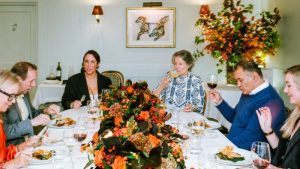How Maggie’s saved me
“The treatment isn’t working. They want to start chemo.” Not the words anyone wants to hear.
It is the middle of the night, in mid-February, when my phone rings. I am in Hawaii, staying with a friend, tagging some beach days onto the end of a work trip. Before my husband Robert has spoken, I mumble to him that he must have got the time wrong and hang up. Then I remember he has been to see his oncologist. I call him back.
We have been living with cancer for nearly 10 years. My husband, Robert, has both CML (chronic myeloid leukaemia, treatable with daily medication) and stage 4 metastatic prostate cancer that, despite multiple treatments, has crept around his body. The cells are spreading to his ribs and sacrum. His cancer is not going away. Each set of treatments brings its own side effects: intense fatigue, violent cramps, nausea. Still the cancer remains.
I put the phone down and think about our children – five between us – and the five conversations that now need to be had. And the five people who will then put their phones down and cry, just like I am doing.


It’s a month later, and I am navigating Hammersmith roundabout on a Lime bike during rush hour, as I head to my first appointment with Troy Chase, a clinical psychologist at Maggie’s. Maggie’s is a cancer support centre nestled in a leafy oasis in the corner of the car park of Charing Cross Hospital in west London. It is one of 24 Maggie’s centres in the UK, all attached to hospitals that specialise in cancer treatment. Maggie’s offers help to anyone who has been affected by cancer, providing free care and support from cancer nurses, psychologists and holistic therapists as well practical support for patients, their families and those who give cancer sufferers care.
More than three million people live with cancer in the UK, a figure that is predicted to rise to 3.5 million by 2025. Nearly half of those born in the UK since 1961 will be diagnosed with cancer in their lifetime. In the past three months, two of my closest friends have also been diagnosed.
Since Robert’s diagnosis, I’ve spent a lot of time sitting in oncologists’ offices. I’ve noticed that when the news is bad, the doctor will come around the desk to be more “personal” while delivering a devastating blow. They will often ask me gently how I’m doing as we are ushered out of the office. They are caring people, but they have patients waiting and there isn’t time to deal with the emotional fallout that accompanies a diagnosis.

Mostly we are left, blinking and bewildered, stuck in a world that feels anything but real, trying to absorb whatever information has been delivered in the 30-minute appointment. Instead, we sit in the car and I try to keep up a jaunty chat as we start figuring out how a new treatment will fit into our lives. How to rejig our work schedules? Should we cancel our summer holiday, again? How we won’t see our friends because we know he’ll be feeling like shit. I delete my Instagram; I don’t want to know what other people are doing. All the time we are trying to process what any of it means. We run scenarios through our heads. Neither of us wants to voice them.
I know I’m not the patient, but I desperately want to be looked after. My parents are both dead and I miss them horribly. I want a “grown-up” to help me, hug me, support me. “Make sure you take care of yourself in order to take care of him,” friends advise, while telling me what a good wife I am being – like I have had some say in the matter.
When someone suggests I visit Maggie’s to see if it might be helpful, I realise it hasn’t occurred to either of us to look to a charity organisation for help. I think, because Robert has private medical insurance, we feel there are people who have more need for it. But cancer isn’t means-tested. And neither is Maggie’s. No one has to sit stunned in their car, not knowing where to turn. Anyone and everyone can walk out of that doctor’s appointment and straight into the warm embrace of their nearest Maggie’s centre.


I feel my shoulders drop the moment I arrive in the leafy garden, designed by Dan Pearson. I love the bright red building, inspired by Richard Rogers’s concept of a heart embedded in the protective wrap of a building’s four walls. I am greeted by a large, bright kitchen with a big table at its centre. A smiling volunteer offers me a cup of tea.
“Tell me about your marriage before the cancer, and then tell me about it now?” asks Troy, a bright-eyed, immensely likeable, dapper Barbadian with a impressive collection of stripy socks. He nudges the tissue box towards me. His role is to help me by focusing specifically on the cancer and its impact on me. I like his immediate warmth and compassion, and his direct questions. He tells me that as well as seeing how I am doing, he is looking for signs to make sure that my mental health is not suffering. It’s not unusual, he says, for relationships to collapse under the pressure of cancer. I am amazed. There are often times I feel locked in a kind of cancer prison, and I can feel very lonely and resentful, but I would never imagine walking away. But, then, I have been the lucky one. I have had a good relationship with Robert; we have a strong foundation. Many people don’t.
Between my visits to Troy, if things get tough I drop into Maggie’s to chat to the oncology nurses. Cancer is everywhere. King Charles III has been diagnosed with prostate cancer; the Princess of Wales is also about to undergo a course of treatment for an undisclosed cancer. I feel for the royal family (Queen Camilla is the patron of Maggie’s centres), because they must bear their illness alone. That family is experiencing the same fear and uncertainty as thousands of others, but they don’t have the luxury of being able to drop into this nurturing space for a chat, a cup of tea and a custard cream.
Maggie’s is named after Maggie Keswick Jencks, a writer, gardener and designer who was first diagnosed with breast cancer in 1988 at the age of 47. She died in 1995. During the latter part of her illness, having endured an interminable time spent sitting in impersonal hospital waiting rooms, she decided the harsh environment in which she was treated only added to the stress and bewilderment that came with diagnosis. Her vision? An inclusive space adjacent to the hospital where cancer patients and their families could find peace and support.

Keswick Jencks’s vision was brought to life by her oncology nurse, Dame Laura Lee, who is today the centre’s CEO, and Keswick Jencks’s close friend, Marcia Blakenham, who has overseen things since opening the first Maggie’s centre in Edinburgh, in 1996. The duo have since worked together to open the two dozen centres now in the UK: numbers 25 and 26 are in construction, and another five are in the planning phase. Each is designed by a leading architect and landscape gardener, among them Frank Gehry with Arabella Lennox-Boyd; Rem Koolhaas with Lily Jencks; Níall McLaughlin with Tom Stuart-Smith (who donated his 2024 RHS Chelsea garden to be relocated to a new Maggie’s centre in Cambridge), and Thomas Heatherwick with Balston Agius. Many of them were friends of Maggie and Charles Jencks, her husband, an architectural historian and landscape designer.
How to donate
UK donations
Each of Maggie’s 24 centres across the UK costs more than £1,500 to open for one day. Supporter donations enabled 300,000 visits from people with cancer – as well as family and friends – in 2023. maggies.org/give
International donations
There are also a number of international Maggie’s:
Maggie’s Barcelona fundaciokalida.org/es/colabora
Maggie’s Groningen maggies.org/our-centres/maggies-groningen
Maggie’s Hong Kong maggiescentre.org.hk/zh
Maggie’s Tokyo maggiestokyo.org
The Maggie’s model has become the lodestar for hospitals across the world: there are now overseas centres in Tokyo, Hong Kong, Barcelona and the Netherlands, and one in development in Norway. It costs millions of pounds for a new building and £600,000 a year to run each one. The charity relies on a multi-pronged fundraising approach involving major donors, events, community efforts and corporate sponsors to fund its free support.
“I think, for some families, receiving kindness is often quite difficult,” says Lee. “But in fundraising there is something magical in giving and receiving that happens within that space. Donors also have so much more that they can help us with. Money is wonderful, but they can also offer skills and expertise that are invaluable to us.”
I first met with Lee, an attractive, charismatic and empathetic Scot, on the premise of discussing Maggie’s for this piece in a journalistic, inquisitive but ultimately impersonal way. I spent that first meeting in tears. I was too overwhelmed by my personal circumstances to be any kind of journalist. She suggested that it might be more helpful if I paused on the professional, and came back to meet their in-house clinical psychologist, which is what led me – by Lime bike – to Charing Cross and Troy.


Things are at their worst during the chemo. At Maggie’s (now a regular session; we try to meet most weeks), Troy suggests practical questions I wouldn’t have known to ask Robert’s oncologist. He gives me different exercises to help me manage stress and listens to me when I tell him that I am finding it impossible to work. He gives me a space to voice my worst fears and he makes me laugh, which is amazing because crying all the time is draining. I talk to him about what the future might look like, and about our children, who are adults, and how they need to find the balance between supporting their parents and living their own lives. Troy has been there to help me navigate this story.
Robert is less keen on using the centre. It takes me weeks to persuade him to go. It’s a pride thing. Throughout his illness he has been stoic, but he isn’t coping and neither am I, and so eventually, weeks after my first visit, I bundle him into the car and bring him along. It isn’t easy for him; it often isn’t for men. We sit on a large wooden bench in that lovely garden, specifically designed to give people the pause they might need to summon up the courage and energy to go inside.
Some people withstand chemotherapy better than others. Robert is already quite fragile after so many different treatments at the age of 72. For a couple of days after the infusions he is flying high on the steroids given to him to combat infection. He attacks the garden and the washing-up with a manic energy, shouting furiously at me about anything, from the noise of the doorbell to my selfishness for not understanding how he feels. Then he apologises and becomes tearful. I reassure him that it isn’t him talking, it’s the medication. Normally, I would have wanted to punch him, but I have gone into practical mode. I often feel as though I am watching what’s happening as if from a distance. And the symptoms are brutal: he sleeps a dirty, poisoned-filled sleep – that never gives him any rest – for 18 hours a day, groaning from the pain in his bones. I wake in the night to the sound of him vomiting. His hair starts to fall out and our daughter Molly shaves his head. I don’t think I’ve ever been so moved as when I watched her holding his head tenderly in her hands. Molly, who is wiser than me, tells me I am dissociating. It makes sense. There just isn’t time for feelings.
It’s been three months since I first visited Laura Lee and the team at Maggie’s. Robert has stopped having chemo; he became too weak to finish the full course. He is soon to start another medication that will be less brutal on his body. Things are easier for us both; it helps that we both work from home so he can rest when he needs to. His hair is growing back: short, silver and beautiful. Last week we climbed down the rocks to our favourite beach in Cornwall and swam in the water together as we have done for nearly 30 years. I have never appreciated anything so much.
I still visit Maggie’s centres. I know I will continue to need them to help carry me along this road and that they will be there for me and families just like mine, long after my story ends. And I could not be more grateful for that certainty.
Five more Maggie’s centres

Aberdeen
Designed by Oslo-based studio Snøhetta to resemble the shape of a pebble or a shell, the centre is located among sculpted green lawns and rows of beech and cherry trees.

Forth Valley
Set on a tranquil lochan in ancient woodland, this timber boathouse style was designed by London-based duo Thore Garbers and Wendy James to blend seamlessly into the landscape.

Barcelona
Created by Benedetta Tagliabue, with interior design by Patricia Urquiola, the building flaunts a red-brick façade with lively geometric patterns to complement the neighbouring art nouveau hospital.

Yorkshire
Heatherwick Studio conceived this structure as three large-scale planters, taking inspiration from Maggie Keswick Jencks’s love of gardening. The rooftop garden designed by Balston Agius contains more than 23,000 bulbs and 17,000 plants.

Swansea
For optimal uplift, Japanese architect Kisho Kurokawa conceived a swirling structure reminiscent of the Milky Way.
#Maggies #saved








